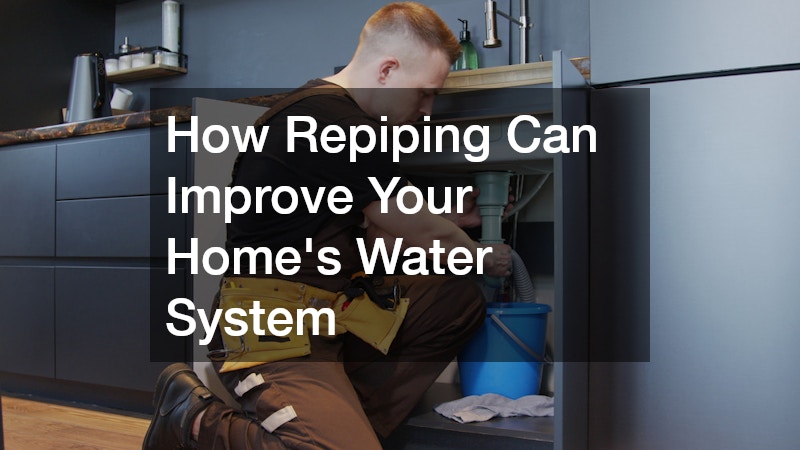This article explores the benefits of repiping in enhancing your home’s water system, addressing common concerns and questions homeowners have about the process. In today’s modern world, the quality of our home’s water system is more critical than ever. Homeowners often underestimate the impact of old, corroded pipes on their water supply.
As awareness grows about health standards and plumbing efficiency, many are considering the option of repiping to improve their water systems.
What is Repiping, and Why is it Necessary?
Repiping involves the replacement of old, worn-out pipes in a home with new materials to ensure a more efficient water delivery system. Over time, pipes can corrode, leak, and even burst, leading to water damage and costly repairs. This replacement process not only fixes current issues but also prevents future problems, providing peace of mind to homeowners.
Repiping becomes necessary when you encounter persistent plumbing issues such as frequent leaks or sudden changes in water pressure. Aging pipes can significantly reduce the efficiency of your water system, leading to higher utility bills and less reliable water service. Understanding the importance of repiping can save homeowners time, money, and frustration in the long run.
Furthermore, modern materials used in repiping are designed for longevity and efficiency. With advancements in plumbing technology, homeowners can choose from various materials that better suit their specific needs and local building codes. Investing in repiping is a proactive measure that enhances the home’s overall infrastructure and significantly increases property value.
How Does Repiping Improve Water Quality?
The quality of your water supply can be severely impacted by the state of your plumbing. Old pipes can harbor rust, sediment, and even harmful bacteria, leading to contamination of the water. When homeowners repipe their systems, they effectively remove these contaminants, ensuring cleaner and healthier drinking water. The transition from older materials to more modern solutions can greatly enhance overall water quality.
Repiping not only restores clear, good-tasting water but reduces the risk of health issues associated with contaminated supplies. It allows for improved flow rates, which can make a notable difference in daily activities like cooking, cleaning, and bathing. Homeowners who undergo repiping often report a significant improvement in the taste and appearance of their water; eliminating unpleasant odors and discoloration.
With a fresh piping system, appliances and fixtures that utilize water also function better, prolonging their lifespan and efficiency. This transition grows increasingly important as families become more health-conscious about their water sources. Repiping ultimately leads to a healthier home environment and enhances the quality of living for all occupants.
What Are the Signs That Your Home Needs Repiping?
Homeowners should be vigilant for several signs that may indicate it’s time for repiping. Frequent leaks or areas of dampness around walls and ceilings can highlight hidden plumbing failures. Low water pressure is another common warning sign that old pipes may be chronically obstructed with rust or mineral buildup and that the system requires inspection.
Discolored water can often be a significant red flag; rusty or brown water is indicative of corrosion inside the pipes. If you notice a metallic taste, it may be time to consider repiping as an option. Water quality is paramount for health, and recognizing these symptoms early can prevent further damage and restore proper system functionality.
What Types of Piping Materials are Used in Repiping?
There are several modern options available for repiping, each offering unique advantages. Copper pipes have long been favored for their durability and resistance to corrosion, making them a popular choice among homeowners. However, they may come at a higher cost compared to other materials, thereby affecting the overall budget for repiping.
Another material gaining popularity is PEX (cross-linked polyethylene). PEX is flexible, resistant to scale and chlorine, and does not corrode, making it an excellent choice for repiping projects. Its ease of installation can also lead to reduced labor costs, allowing for a smoother, quicker repiping process.
How Much Does Repiping Cost and How Long Does it Take?
The cost of repiping varies significantly based on the size of the home and the materials chosen. On average, homeowners can expect to pay anywhere from $2,000 to $15,000 for a complete repiping. This investment can seem daunting, but the long-term benefits of enhanced water quality, increased property value, and reduced maintenance costs often outweigh the initial expenses.
Additionally, the timeframe for repiping largely depends on the scale of the project. Generally, a repiping job can take anywhere from one to several days to complete. Factors like the type of materials used and the complexity of the plumbing system can influence the duration. Homeowners should discuss timelines with their contractor to ensure a clear understanding of what to expect.
Repiping is a significant investment that can greatly enhance your home’s water system, ensuring better water quality, improved pressure, and a more efficient plumbing system. Understanding the necessity of repiping, recognizing signs that indicate it may be time, and knowing what options are available can empower homeowners to make informed decisions. The results will lead to a healthier, more secure living environment for all members of the family.


